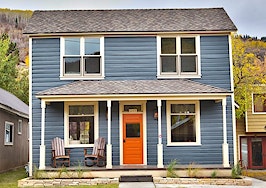- Historic properties have different insurance coverage needs.
- Market value and insured value are two distinct values that should not be compared.
- Recent changes to the National Flood Insurance Program affect all, including historic properties.
Whether you are helping your client to purchase or sell a historic home, there seems to be a lot of insurance misconceptions in the real estate industry regarding what is covered. We wanted to help set the record straight so that you can arm yourself with some basic information that will help you direct your clients to an appropriate insurance carrier to protect one of their biggest assets in life — their property.

Andrei Medvedev / Shutterstock.com
Many large insurance companies are hesitant to cover historic homes due to being unfamiliar with how to assess potential losses for these unique dwellings. Luckily, there are independent insurance brokerages all across the country who represent high net worth insurance companies that have no problem insuring homes that are 50 years or older, which makes the home historic.
One of those independent brokerages is National Trust Insurance Services, a subsidiary of the National Trust for Historic Preservation that specializes in carriers that cover commercial and residential historic properties. We tapped into the experts there to get these five facts.
1. Be on the lookout for red flags
Certain materials and building methods used in historic homes (that were appropriate at the time of construction) have fallen out of favor due to safety and health concerns, and they might require remediation before an insurance company will provide coverage.
For example, knob-and-tube wiring (which can put historic homes at risk for fire), asbestos used for insulating pipes, and lead paint (which can cause birth defects and other health issues) might all need to be remediated either before a sale or purchase to obtain coverage.
Each carrier has different requirements, so check to find out the nuances from each insurance provider.
2. Get a proper valuation
Studies show that nearly 60 percent of homes in the U.S. are underinsured, and they are underinsured by at least 18 percent.
If your home suffered a total loss, the owner would be responsible for a significant portion of rebuilding costs. Replacement costs for a historic home can include specialty architects, permits and updates to systems to make the home meet current building codes. If you have concerns about what your replacement cost comes back at, discuss it with your agent.
Some insurers use functional replacement cost, which means that they might not cover the cost of rebuilding with materials of like, kind and quality. This would be very unfortunate for a historic homeowner because the property would lose its architectural significance and originality.
High-net-worth companies such as Chubb, Pure, AIG and Travelers, for example, offer guaranteed replacement, but require the home be insured at 100 percent of its value to be eligible for the guaranteed replacement cost. Market value and insured value are two distinct values that should not be compared.
[Tweet “Market value and insured value are two distinct values that should not be compared.”]
3. Reduce your insurance burden and out-of-pocket costs at the time of loss
Here’s how:
- Select a company that includes sewer backup in the language of the historic homeowner’s contract.
- Ask your agent to add systems and equipment breakdown coverage to your policy; this keeps your client from paying for damages to home systems including kitchen appliances, generators, hot water heating and heating/air conditioning.
- Bundle your policies with one carrier; you will receive policy discounts when you do this.
- Consider a collections/fine arts policy and make sure items are classified appropriately.
- Keep detailed reports of your home’s unique features to help recreate them to exact specifications in the event of a loss; photograph your home and its architectural details periodically, or better yet, take video of your home.
- Consider carrying a larger deductible — most companies provide larger discounts for policies with larger deductibles.
- Choose a company that offers the disappearing deductible for a large loss of your client’s historic property.
4. Choose an independent insurance brokerage
Benefits of choosing an independent brokerage:
- Your agent will do an insurance audit each year to help ensure that all of your client’s risks are properly insured and to make sure that your client is not underinsured.
- During the audit process, your agent will check to see if any upgrades to the home (such as a security system or certain system upgrades) will reduce your client’s insurance burden. There might be additional savings found while assessing content coverage and classification.
- An independent agent has access to multiple markets for affluent/high net worth carriers. This helps to protect your client from paying more than they should.
- Independent agents are available to the client 24/7 and make themselves available to the client outside of the regular business hours.
- Privacy is a top priority to an independent agent. Their experience working with LLCs and trusts that hold personal use property is also a significant benefit.
Independent brokerages also understand many insurance products over a wide spectrum of risks, including historic homes, classic cars, custom built yachts and fine art.
5. Be aware of flood insurance policies
In the past five years, all 50 U.S. states have experienced floods or flash flooding. Everyone lives in a theoretical flood zone — some folks are just higher risk than others. This makes it hard to reduce your client’s risk, but that’s what insurance is for. If maintained properly, flood insurance lessens the severity of a potential loss.
Recent changes to the National Flood Insurance Program affect everyone, including historic properties and districts. Because no area is immune to the increased disasters, it is important that your clients maintain the proper insurance coverage to lessen the blow of a major storm since costs have gone up.
[Tweet “Recent changes to the National Flood Insurance Program affect all, including historic properties.”]
For new and renewing policies, there is a $25 surcharge for primary homeowners and a $250 surcharge for non-primary homeowners. A non-primary residence is defined as living at the property for less than 50 percent of the time.
All premiums are going up: Depending on the property’s size and location, annual premiums could spike along with added fees and surcharges, so policyholders are looking at an annual increase of around 10 percent over the next five years. Premiums cannot increase more than 18 percent a year for primary residence policies and 25 percent for secondary residences or properties. Ultimately, all flood zone insurance policy costs are only going in one direction — up.
Flood maps are changing: If your client purchases a policy before a new map’s effective date, your client can lock in a rate at the previous zone level. This will not prevent rate increases, but it might slow the rate at which the increases happen.
Higher deductibles are available: The residential deductible limit is now $10,000. A higher deductible helps to lower the premium, but limits do have to be pre-approved by banks. With a $10,000 limit, flood insurance becomes a catastrophic insurance policy Grandfathered rates will be phased out in 2016.
To learn more about National Trust Insurance Services, you can visit them on their website.
Meggen Taylor is a co-founder of FindEverythingHistoric.com.





